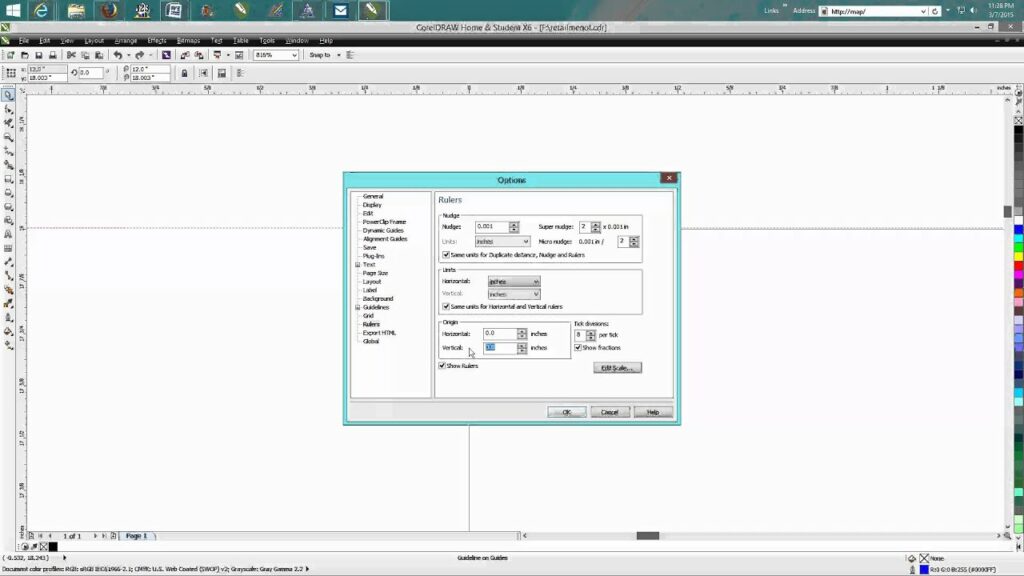Precision Unleashed: A Comprehensive Guide to Calibrating Rulers in CorelDRAW

Introduction
In the intricate world of graphic design, CorelDRAW stands as a powerhouse, offering a canvas for creative expression. One of the fundamental tools empowering designers is the ruler feature, providing a visual guide for precision and alignment. This comprehensive guide delves into the art of calibrating rulers in CorelDRAW, unlocking a realm of accuracy and control for designers seeking perfection in their projects.
Section 1: Understanding the Need for Ruler Calibration
1.1 The Essence of Precision in Design
Before delving into the technicalities, it’s crucial to understand the essence of precision in design. Rulers serve as navigational aids, and calibrating them ensures that measurements are accurate, enabling designers to create layouts with meticulous precision.
1.2 Tailoring Rulers to Design Requirements
Explore how calibrating rulers allows designers to tailor the measurement system to specific design requirements. Whether working in inches, centimeters, pixels, or other units, calibration ensures that the ruler aligns seamlessly with project specifications.
Section 2: Accessing Calibration Options in CorelDRAW
2.1 Locating Ruler Calibration Tools
Dive into CorelDRAW’s interface to locate the ruler calibration tools. Understand where to find the options that allow you to calibrate both horizontal and vertical rulers, ensuring that your measurements are accurate across the entire workspace.
2.2 Configuring Calibration Units and Increments
Explore the customization options for calibration units and increments. Whether calibrating for print or digital media, learn how to configure the rulers to match the specific units and increments required for your project.
Section 3: Horizontal and Vertical Calibration
3.1 Calibrating Horizontal Rulers for Pinpoint Accuracy
Delve into the calibration process for horizontal rulers. Learn how to ensure that measurements along the x-axis are precise, allowing for accurate placement and alignment of design elements.
3.2 Vertical Calibration: Elevating Measurement Confidence
Understand the significance of vertical calibration for the y-axis. Explore techniques to calibrate vertical rulers, guaranteeing that measurements along the y-axis are equally accurate for a perfectly aligned design.
Section 4: Techniques for Manual Calibration Adjustments
4.1 Fine-Tuning Calibration Manually
Master the art of manual calibration adjustments. Explore techniques for fine-tuning calibration settings to accommodate specific design scenarios, ensuring that measurements align with project requirements.
4.2 Calibrating Rulers for Diverse Design Projects
Understand how to calibrate rulers for diverse design projects. Whether working on large-format prints or intricate digital illustrations, learn techniques to adapt calibration settings for different scales and levels of precision.
Section 5: Calibrating Rulers in Page Layout and Document Setup
5.1 Optimizing Calibration for Page Dimensions
Explore how calibration plays a crucial role in setting up page dimensions. Learn how to calibrate rulers to define the size, orientation, and margins of your pages, ensuring that your document adheres to specific design specifications.
5.2 Bleeds, Margins, and Calibrated Ruler Guides
Understand how calibrated rulers interact with layout elements such as bleeds and margins. Explore techniques for calibrating ruler guides to maintain consistent design boundaries, ensuring precision in layout composition.
Section 6: Dynamic Calibration Features: Grids and Guidelines
6.1 Grid Calibration for Systematic Design
Delve into the calibration of grids as dynamic features. Explore how calibrated grids provide a systematic framework for design elements, enabling designers to create layouts with uniform spacing and alignment.
6.2 Guidelines: Calibrated Precision Points
Understand how calibrated guidelines enhance precision. Learn how to calibrate guidelines to establish reference points for aligning and positioning elements within your design, ensuring accuracy in complex layouts.
Section 7: Advanced Calibration Techniques for Specialized Design
7.1 Calibrating for Rotated Designs
Explore advanced calibration techniques for rotated designs. Understand how to calibrate rulers to accommodate non-traditional orientations, ensuring that measurements remain accurate even in projects with unique angles.
7.2 Calibrating Rulers for Scaled Designs
Master the art of calibrating rulers for scaled designs. Explore techniques for maintaining accuracy when working with resized elements, ensuring that measurements and proportions align seamlessly during transformations.
Section 8: Calibration Shortcuts and Productivity Hacks
8.1 Time-Saving Calibration Shortcuts
Enhance your workflow with time-saving calibration shortcuts. Explore keyboard commands and quick-access features that streamline the calibration process, allowing you to navigate and manipulate rulers with efficiency.
8.2 Creating and Applying Calibration Presets
Learn how to create and apply calibration presets for efficiency. Explore the benefits of saving and loading specific calibration configurations, ensuring that your preferred settings are readily available for different design scenarios.
Section 9: Calibration for Output and Export
9.1 Printing Designs with Calibrated Layouts
Understand how calibrated rulers contribute to precision in printed designs. Explore print settings and layout considerations, ensuring that calibrated layouts translate seamlessly from the digital canvas to the physical medium.
9.2 Exporting Designs with Calibrated Precision
Prepare designs for digital platforms by exploring export options with calibrated precision. From creating PDFs to optimizing for online display, learn how to export designs for a variety of digital contexts while maintaining the intended calibration accuracy.
Section 10: Troubleshooting Calibration Issues
10.1 Addressing Common Calibration Challenges
Navigate through common challenges associated with ruler calibration. From discrepancies in measurements to unexpected changes in calibration behavior, explore troubleshooting techniques to maintain control and accuracy in your design projects.
10.2 Reverting Changes and Undoing Calibration Actions
In case of unintended consequences, understand how to revert changes and undo calibration actions. Learn the steps to correct any alterations made in error, ensuring that the integrity of the project is preserved.
Section 11: Best Practices for Calibrating Rulers
11.1 Efficient Calibration Workflow Strategies
Embrace best practices for an efficient calibration workflow. From organizing your rulers to using grids and guidelines, adopt principles that optimize your design process, enhancing the overall workflow.
11.2 Documentation for Calibration Conventions
Maintain documentation for calibration conventions. Explore strategies for documenting specific calibration configurations and settings, ensuring that the design history is preserved and facilitating collaboration or revisions down the line.
Section 12: Conclusion
In conclusion, the art of calibrating rulers in CorelDRAW is not just about measurements; it’s about unlocking a realm of precision and control for designers. Embrace the tools, techniques, and considerations discussed in this comprehensive guide, experiment with different calibration strategies, and embark on your design journey with newfound accuracy. The canvas is vast, and with calibrated rulers as your guide, your creative expressions in CorelDRAW become an immersive and precise experience.






